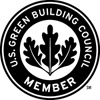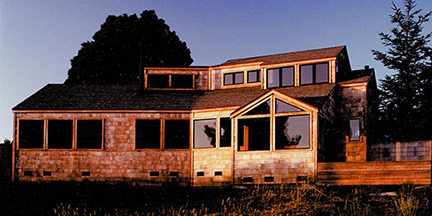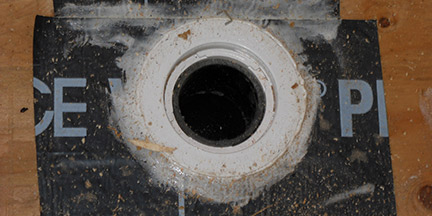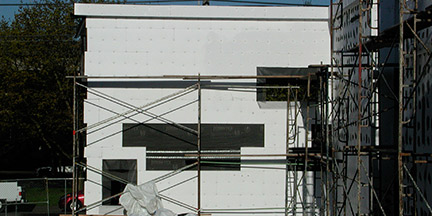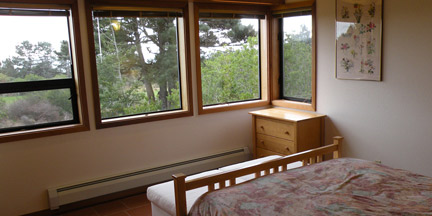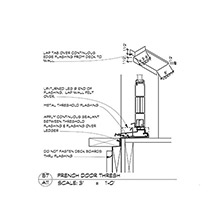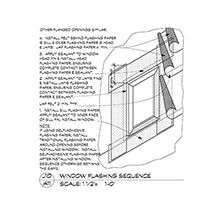|
Click on the photo to go to the project page.
Environmentally Responsible Architecture
What is Environmentally Responsible (“Green”) Architecture?
In our opinion, environmentally responsible architecture includes the
following characteristics:
1.
Efficient use of space.
Part of reducing a building’s impact on the environment involves
making it no larger than it needs to be. The smaller building is, the
less heat it loses or gains, reducing energy use. The smaller it is, the
less “embodied energy” (energy required to create, manufacture,
transport, and install a building material) is invested in a building.
The smaller a building is, the more green space remains available around
it to convert carbon dioxide to oxygen or allow rain water to be absorbed
into the soil. Our clients and their guests often remark on how our designs
seem larger inside than one would expect looking from the outside. We
do this through working with our client’s spatial program and the
site (requiring substantial amounts of tracing paper, which we recycle),
until we have come up with the most efficient use of space, while at the
same time providing the most spacious possible feeling. We have placed
this principle first because, other than not building at all, the most
important green building principle is to build as little as possible.
This approach also saves our clients money. They don’t have to pay
for extra building they don’t need. This gives them the freedom
to select nicer finishes than they could with a larger building, and still
meet their budget.
2. Timeless design.
Buildings have a limited economic life. We seek to maximize the economic
life of the buildings we design though design which appears timeless.
Buildings which are designed in the latest architectural vogue, like all
fashion, go out of fashion. They then need to be remodeled, at the cost
of additional material and energy use, because they have become “dated.”
This aspect of environmentally responsible architecture and green building
is in our opinion cost-neutral, but we believe it provides a more valuable
building.
3. Built for permanence.
Contemporary society places a high emphasis on initial cost. This comes
at the expense of durability. The cheapest materials for the job are usually
less durable than many of the alternatives. Constructing a building with
careful attention to flashing details and designing for normal anticipated
wear and tear costs more than constructing it the cheapest way possible.
We inform our clients about the relative costs and characteristics of
their material options so they can make informed decisions. We put considerable
care into our detailing to ensure it is resistant to deterioration. In
addition to strong technical skills, we bring the experience of numerous
inspections of existing buildings. This has taught us how buildings fail,
so we can design our buildings to resist failure. None of our buildings
have needed to have their exterior finish removed to correct rot, and
be put back together. We have, however, assisted many owners in this process,
correcting the errors of other architects or the construction contractors.
Working on these kinds of projects has also given us invaluable experience
on how to prevent these problems. Building for permanence typically brings
higher initial costs than the speculative builder approach, but more than
pays for itself over the long term.
4. Energy conserving design.
We design our buildings to be as efficient as possible within our clients’
construction budgets. Insulation is typically cheap relative to the fuel
used to condition a building, so we use as much of it as possible. We
encourage the use of windows with good thermal resistance. We incorporate
other energy-conserving features which may not cost any more than a less
efficient design. These can include overhangs which reduce summer over-heating,
or window arrangements which allow natural light to penetrate deep within
the building, reducing the need for electric light. We are lighting design
buffs, and whenever possible we design lighting which works with contrast
ratios to make a space seem brighter than it really is. Often these techniques
can be incorporated in buildings at no additional construction cost. Sometimes
they add a bit to the initial cost, but increase the appeal and lower
the operating costs for the building.
5. Efficient mechanical systems.
We specify high-efficiency mechanical systems unless our clients specifically
ask us not to. These systems typically have a payback period less than
three years, followed by about ten years of cost savings, so they tend
to be consistent with what most of our clients want anyway. When possible
within the construction budget, we use technologies like air-to-air heat
exchangers to provide desirable ventilation together with minimum energy
loss. Lighting is an important aspect of how we experience a building,
and a tool we really enjoy using. We have been working with various high-efficiency
electric lighting technologies for over 20 years. Often people assume
that our high-efficiency lighting designs are incandescent, based on the
pleasant light they provide. High efficiency lighting costs a little more
than the incandescent alternatives, but typically has a payback period
of around three years, followed by many years of cost savings.
6. Environmentally friendly materials.
The quest for ever-cheaper construction materials has produced some that
require a lot of fossil fuels to make, and then can poison us with the
chemicals they release into the air of our buildings. Synthetic carpet
and sheet vinyl flooring are the worst offenders. When our clients’
budgets permit, materials we use include wood, ceramic tile, linoleum
(a cork-based product), or finished concrete for flooring materials. If
feasible within our clients’ budgets, we use low formaldehyde cabinets.
Material selection involves numerous tradeoffs, and understanding of the
environmental impacts of various alternatives is continually evolving.
Ultimately it comes down to our clients' personal priorities. We provide
them with the latest information so they can make an informed choice.
Environmentally friendly materials cost more than the common choices,
though many have lower life cycle costs, when measured over a ten to twenty
year period.
We
are good listeners, and we will work with our client to develop a design
which best meets their objectives. That said, we most enjoy working on
projects which place the greatest emphasis possible on environmentally
responsible architecture. Budget is always a primary consideration, and
the construction budget typically takes precedence over long term operating
costs, so it is usually not possible to reflect all of these characteristics
in each design, but we include as many as possible within our clients’
constraints.
|
